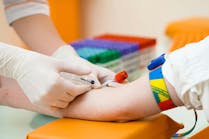Post-vasectomy semen analysis
Q: Physicians who perform vasectomies request a sperm count, so that on the patient's post-vasectomy (PV) specimens, they know if the sperm count is going down or not. Would it be reasonable to report the number of sperm per high-power field (HPF) or in 10 HPFs? How should PV semen analysis be performed and reported?
A: Confirmation of azoospermia is important to establish success of a vasectomy. Typically, two semen samples are tested at least six to eight weeks after a vasectomy. While the World Health Organization (WHO) provides a guide for establishing azoospermia, a specific procedure for performing and reporting PV semen analysis is not provided.1
Semen analysis for PV samples involves two steps: an initial analysis of the neat semen sample for presence of sperm, followed by centrifugation at 1000 x g for 15 minutes if no sperm are seen in the ejaculate. It is important to examine a minimum of 30 high-power fields (HPF; 40x magnification) for both the ejaculate and the pelleted sample. Results are reported for motility and number of sperm seen per HPF.
While most PV samples will have either no sperm or will require repeated testing until no sperm are seen, up to one-third of patients have rare non-motile sperm (RNMS) in the PV semen analysis. Presence of RNMS is the most common call a laboratory will receive regarding PV results. Repeated RNMS is generally considered consistent with a successful vasectomy.2
—Dean Morbeck, PhD, Director
Fertility Testing Laboratory
Mayo Clinic
Rochester, MN
References
- World Health Organization. WHO laboratory manual for the examination of human semen and sperm-cervical mucus interaction; 4th ed. Cambridge: Cambridge University Press, 1999.
- Chawla A, Bowles B, Zini A. Vasectomy Follow-Up: Clinical Significance of Rare Nonmotile Sperm in Postoperative Semen Analysis. Urology. 2004;64:1212-1215.
Specimen collection for coag tests
Q: Is collecting for all ordered tests with a 12-cc or 20-cc syringe and butterfly, and transferring to the appropriate tubes acceptable practice for coagulation tests?
A: According to the CLSI coagulation guideline, specimens for plasma-based coagulation studies can be collected directly into a tube, (e.g., through a tube-holder assembly, or drawn into a syringe and transferred into a tube).1 The syringe should be composed of a non-activating surface like polypropylene. A winged device is also acceptable when coupled with a tube holder or syringe. Most syringe draws are uncomplicated and do not result in a prolonged collection. Syringe draws that are prolonged, however, may risk clotting within the barrel of the syringe. Therefore, the guideline recommends that when drawing into a syringe, the syringe should be evacuated into the coagulation tube within one minute of the completion of the draw. Due to the potential for blood to clot within the barrel of the device, syringe sizes of 20 mL or less are recommended. To protect against hemolysis, a slow, steady withdrawal of the plunger of the syringe is less likely to rupture RBCs than pulling on the plunger with excessive force. The use of needles smaller than 23 gauge may also contribute to hemolysis. When evacuating the specimen into multiple tubes, follow the same CLSI-recommended order of draw as when using a tube holder.2 This order places the coagulation tube first (unless blood cultures are also being collected, in which case they would follow the blood culture).
—Dennis J. Ernst, MT(ASCP), Director
Center for Phlebotomy Education
Corydon, IL
References
- Clinical and Laboratory Standards Institute. Collection, Transport, and Processing of Blood Specimens for Testing Plasma-based Coagulation Assays and Molecular Hemostasis Assays; Approved Guideline. 5th ed. CLSI Document H21-A5. Wayne, PA: CLSI; 2008.
- Clinical and Laboratory Standards Institute. Procedures for the Collection of Diagnostic Blood Specimens by Venipuncture; Approved Standard. 6th ed. CLSI Document H3-A6. Wayne, PA: CLSI; 2007.
Prevent carryover of spermatozoa
Q: We process urines on an automated system that is known to carryover sperm to subsequent specimens. Since we are processing primary tubes, we have no uncontaminated specimen to re-process or examine by manual microscopy. All articles I have accessed, including one in MLO, recommend the reporting of sperm in urine, but none address the specific issue of contamination. The vendor says, “Yes, this is known and it is because sperm is viscous.” But now we do not know what is real and what is not. Instrument flagging does not address the main issue. Do you have any suggestions?
A: Before we address the question of how to prevent carryover of spermatozoa in automated microscopy systems, it may be worthwhile to review the arguments for and against the reporting of sperm in urine. In the December 1997 issue of MLO,1 Daniel Baer, MD, late editor of the Tips from the clinical experts section, answered the question of whether spermatozoa seen in a urine microscopic exam should ever be reported. Dr. Baer indicated that the finding of sperm in urine generally does not add useful information. Sperm are usually present in urine due to the expulsion of residual sperm in the urethra following ejaculation or nocturnal emissions. Documentation that sperm were present in urine, however, can have limited clinical value in certain cases of infertility as well as among those with retrograde ejaculation, which can occur as a side effect of certain drugs, after prostate or bladder surgery, or after surgical sympathectomy.
The utility of detecting sperm in the urine of females to implicate child abuse and/or rape is somewhat controversial, and in our opinion questionable, since voluntary sexual activity is always difficult to exclude. In all cases, the presence of spermatozoa in young females is not evidence of child abuse without corroborating historical findings. Furthermore, in cases of possible rape, it is unlikely that sperm would be present in urine while being absent in vaginal fluid. Despite these limitations, Dr. Baer's final opinion at that time was that sperm should be reported with the test results when present, given its occasional value in retrograde ejaculation and infertility.
Over the intervening years, automated urine microscopy instruments have come into widespread use, introducing the additional potential confounder of carryover of sperm from one sample to the next. In our practice, routine urine microscopy is performed using an automated IRIS iQ200 Sprint except among those samples with an elevated protein concentration or abnormal automated microcopy findings (about one-third of the total) which are, instead, subjected to traditional manual microscopy. We only report the presence of sperm in urine samples obtained from males that have an elevated protein concentration (defined as a protein: osmolality ratio > 0.12 (mg/L)/(mOsm/kg), regardless of whether the examination was done manually or on the automated instrument
Our rationale for not reporting sperm, in most cases, is that we believe the clinical utility is limited. In males, however, the presence of semen could artificially raise the protein concentration since seminal fluid has a high protein content. This has been documented by Blumsohn, et al2, who noted that total protein concentrations, albumin, retinol binding protein, and 2 microglobulin measurements were all significantly higher in post-coital initial urine samples compared to midstream samples collected from the same individuals without prior intercourse/ejaculation. A separate study has demonstrated that contamination of post-ejaculatory urine by semen can result in artificially elevated urine protein concentrations in dogs.3
In our experience, nearly all urine samples with sperm also have an elevated protein level. Since proteinuria can indicate kidney disease and, therefore, prompt additional workup, we report the presence of sperm in those samples obtained from males that have elevated protein levels and also recommend repeat urinalysis. If the repeat sample has a normal protein level and lacks sperm, one could attribute the elevated urinary protein to seminal-fluid contamination. Semen in urine can also cause false-positive hematuria by dipstick testing,4 although we have not modified our protocol to account for this possibility.
Although we are not aware of a problem with carryover of spermatozoa using our automated IRIS iQ200 Sprint urine analyzer, in order to screen for this possibility, we have implemented an algorithm to flag any specimen that is positive for sperm that was preceded by another specimen that was also positive. Our recommendation is for your lab to limit the reporting of sperm to male urine specimens with increased protein and/or albumin concentrations. Even if sperm do carryover to a subsequent sample, protein should not. Therefore, if sperm are only reported on samples with elevated protein levels, the problem of falsely reporting sperm should be greatly reduced. Other than that, the only other solutions we can suggest would be to aliquot urine specimens prior to automated microscopy or perhaps to evaluate a different automated analyzer.
—Kazunori Murata, PhD, Fellow,
Clinical Chemistry
—Virginia Ward, Clinical Laboratory Technician,
Renal Function Laboratory
—Timothy Larson, MD, co-director,
Renal Function Laboratory
—John C. Lieske, MD, medical director,
Renal Function Laboratory
Dept. of Laboratory Medicine and Pathology
Mayo Clinic
Rochester, MN
References
- Baer D. Tips from the clinical experts. MLO. 1997;29(12):12.
- Blumsohn A, Price A, Morris B, Griffiths H, Gray T. The effect of semen contamination on the concentration of low molecular weight proteins, albumin and total protein in male urine. Ann Clin Biochem. 1991;42(3):187-188.
- Prober L, Johnson C, Olivier N, Thomas J. Effect of semen in urine specimens on urine protein concentration determined by means of dipstick analysis. Am J Vet Res. 2010;71(3):288-292.
- Mazouz B, Almagor M. False-positive microhematuria in dipsticks urinalysis caused by the presence of semen in urine. Clinical Biochemistry. 2003;36(3):229-231.
Measuring HCT for polycythemia vera
Q: What is recommended for measuring hematocrit (HCT) accurately for polycythemia vera patients? Automated HCT is often lower than spun HCT in this case; some labs use only automated value for HCT and allow about 20% acceptance limit between the two methods. Is such practice acceptable as the value of HCT dictates when to perform therapeutic phlebotomy?
A: Both the automated and microhematocrit methods for measuring hematocrit have potential limitations for their use in the clinical setting. The automated method uses the red blood-cell (RBC) count multiplied by the mean corpuscular volume (MCV) to calculate the hematocrit.1 Errors can be introduced by red-cell aggregates. With the microhematocrit method, errors can occur when samples are not adequately mixed, therefore, alternating the red-cell to plasma ratio.1 Also, inadequate centrifugation can lead to errors secondary to plasma retained in the red-cell portion of the capillary tube.
Treating polycythemia vera to decrease the hematocrit helps to prevent complications including thrombosis. While multiple papers report data in support of this, there is no preferred method for obtaining a hematocrit value.2, 3 There also exists some inherent variability in plasma volume, which is influenced by hydration status among other things.4
For determining the need for phlebotomy in the setting of polycythemia vera, either method is acceptable as a high degree of accuracy and precision are not needed.5
References
- McPherson R, Pincus M. Henry's Clinical Diagnosis and Management by Laboratory Methods. 21st ed. Philadelphia, PA: Saunders; 2007.
- DiNisio M, Barbui T, DiGennaro L, et al.The haematocrit and platelet target in polycythemia vera. Br J Haematol. 2006;136:249-259.
- Schafer A. Molecular basis of the diagnosis and treatment of polycythemia vera and essential thrombocythemia. Blood. 2006;107:4214-4222.
- Tefferi A. Polycythemia vera: a comprehensive review and clinical recommendations. Mayo Clin Proc. 2003;78:174-194.
- Tefferi A. Personal correspondence.
—Elizabeth Jaben, MD
—Eapen Jacob, MD
Division of Transfusion Medicine
Mayo Clinic
Rochester, MN
MLO's “Tips from the Clinical Experts” provides practical, up-to-date solutions to readers' technical and clinical issues from a panel of experts in various fi elds. Readers may send questions to Brad S. Karon, MD, PhD, by e-mail at [email protected].
Brad S. Karon, MD, PhD, is assistant professor of laboratory medicine and pathology, and director of the Hospital Clinical Laboratories, point-of-care testing, and phlebotomy services at Mayo Clinic in Rochester, MN.





